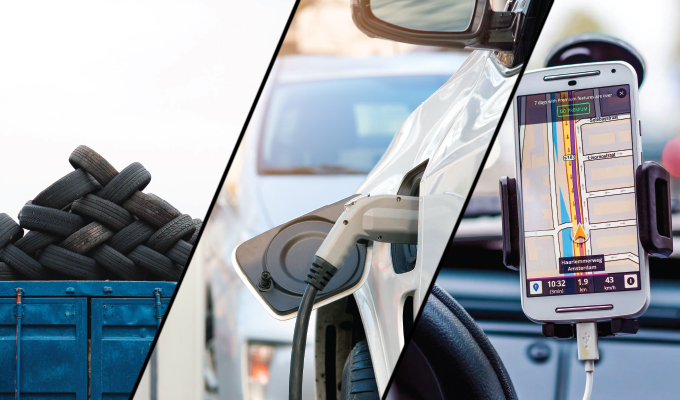By Katreena Sarmiento
Environmental sustainability has transitioned from option to necessity, even in sectors known for heavy carbon emissions.
The United States is second to China on the list of countries with the highest carbon dioxide emissions. Uncontrolled carbon dioxide emissions are alarming in the context of worsening floods and heat waves, with scientists predicting that we only have a decade to prevent irreversible damage from climate change. In an unexpected turn of events, the COVID-19 pandemic led to a record 7% decline in global carbon emissions in 2020 according to Stanford. Considering travel bans and national lockdowns, it is not surprising that emissions from the transportation sector accounted for more than 50% of the drop.
However, to sustain this trend, key players must make a conscious effort and considerable investments; this includes the transportation industry. Implementing a sustainable strategy in trucking or any other industry requires planning and commitment. Fortunately, trucking is becoming sustainable through advancements in technology, fuel alternatives, and best green practices.
TECH ADVANCEMENTS
While several significant technological innovations have led to more sustainable trucking, this section will focus on telematics and route optimization.
Telematics combines vehicular technologies, telecommunications, computer science, and electrical engineering to gather information about a vehicle or an entire fleet. Specifically, fleets can use telematics to monitor travel speeds and locations. This can help reduce fuel consumption and discourage negative driving habits. For instance, a driver’s records can reflect instances of speeding, harsh braking, sudden acceleration, and idling. Reminders and reinforcements can put errant drivers back on track, ultimately saving fuel and boosting safety.
Additionally, optimized route planning also proves useful. Route optimization doesn’t only choose the shortest path. Factors such as weather and traffic must also be considered because they can similarly delay a driver. To be specific, if a driver gets stuck in traffic, they will use more fuel. An abundance of routing technologies are available on the market, and many use artificial intelligence (AI) to predict and avoid traffic or bad weather. As a result, truck drivers use less fuel, avoid idling, and cut delivery time. As the pandemic changes shopping trends in favor of online purchases, shorter delivery time becomes increasingly valuable.
FUEL ALTERNATIVES
In addition to tapping into useful technologies, companies looking for greener energy sources in trucking consider biodiesel and electric vehicles as top choices.
Produced from organic plant and animal materials, biodiesel releases fewer greenhouse gases. Further, it reduces food waste, as restaurant grease is one source of biodiesel. More importantly, biodiesel does not compromise performance in trucks. Diesel engines are ubiquitous in the trucking industry, and biodiesel works perfectly fine with them. Consequently, biodiesel is the number one choice of alternative fuel among fleet owners.
Battery-electric vehicles (BEVs) and fuel-cell-electric vehicles (FCEVs) are also two of the most talked about options in alternative fuels. Truck manufacturers develop BEVs and FCEVs with the hope that pressures from society and the government will make these vehicles more attractive to buyers.
BEVs feature smaller, lighter batteries that are easier to clean and recharge. However, the challenge lies in battery life. Pilot studies show that BEVs perform best in the short-haul segment. On the other hand, hydrogen powers FCEVs, and they only emit water and hot air. However, FCEVs pose a challenge in terms of hydrogen storage as well as energy efficiency. Storing large amounts of hydrogen in gaseous form requires large-volume gas tanks, and these tanks will leave a significant carbon footprint. Additionally, one cycle of electrical energy production reduces FCEVs’ energy efficiency by 50%.
BEST GREEN PRACTICES
Outside inventions and energy sources, some green initiatives from the trucking industry are also commendable. Several trucking companies started green initiatives worth emulating including Canada’s United Van Lines. Its initiatives include recycling tires and cartons and using reusable quilted furniture pads and runners. These practices are especially beneficial for trucks used often or for a long time. On top of this, regularly scheduling maintenance and repairs can help reduce carbon dioxide emissions by keeping trucks in top shape. Fleets can also use management to set up schedules and reminders for these activities.
Another green practice for trucks involved in delivery services is to change the materials used in packing. For example, choosing bubble wrap over polystyrene (Styrofoam) is more eco-friendly because bubble wrap is 75% cheaper. Plus, it’s recyclable and polystyrene is not.
The green revolution is the most logical path to take in a world beset with several life-changing challenges. The trucking industry is not a pioneer in this route. But with the latest technologies, better fuel options, and emerging green practices, the industry can continue to help slash carbon Emissions across the globe.
ABOUT THE AUTHOR
Katreena Sarmiento is a scientist and a life hack specialist. She’s authored scientific journals on biotechnology and molecular biology. To take a break from scientific journals, she puts her mind into writing about lifestyle, health, and sustainability. She strongly believes that kindness makes the world go round. Reach her at katreens.contentstudio@gmail.com.




